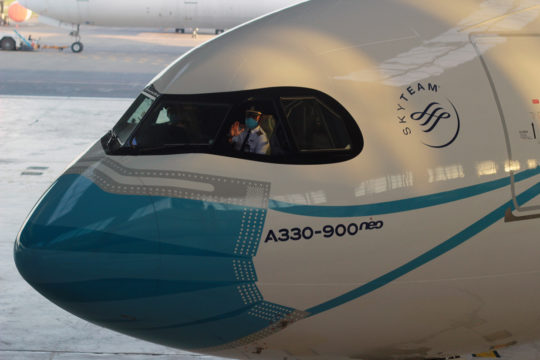Photo Credit: Antara
To support Indonesia’s and global efforts to educate the public on the need to wear face masks to prevent the spread of COVID-19, the Indonesian National Carrier has enthusiastically embraced the Government of Indonesia’s “Let’s Wear a Mask” (Ayo Pakai Masker) campaign.
Kompas.com reports that Garuda Indonesia has repainted the livery of five Airbus A330-900 NEO aircraft and published the pictures on its social media network, including Twitter at @IndonesiaGaruda.
Garuda’s CEO, Irfan Setiaputra, has restated his support for all steps undertaken by the Indonesian government to limit the coronavirus’s spread. “It is a distinct honor for us to be the first national airline in Indonesia to display a special livery for aircraft with featuring masks,” he said.
Saying active community-wide support is needed to prevent the spread of the COVID-19 Pandemic, Setiaputa added: “Hopefully, what we do as an airline will also increase public awareness of the need to observe health protocols in our everyday life, especially through the use of masks.”
Irfan explained that there are five Garuda Indonesia planes whose fuselage’s nose now features a painted mask. These planes will serve both domestic and international routes, including the destinations of Singapore and Japan.
Meanwhile, the Chairman of the Committee for Mitigation of COVID-19 and National Economic Recovery (KPCPEN), Erick Thohir, expressed his appreciation for the initiative carried out by Garuda Indonesia. “The highest appreciation from the Committee to Garuda Indonesia for taking an active role in socializing the use of masks in this unique way. The plan is that apart from within the country, there will also be routes that go abroad. This is very good so that the world community also knows that Indonesia is ‘number one’ in health management, “said Erick.
In addition to requiring the use of masks, Garuda Indonesia also follows all other health protocols in every aspect of its operation. This includes regulated physical distancing in its seating configuration and the minimalization of person-to-person contact in food and beverage service. Each aircraft also undergoes a routine disinfection process after each flight and is equipped with an in-cabin atmospheric filtration process that removes 99.97% of all particulate matter and viruses.
